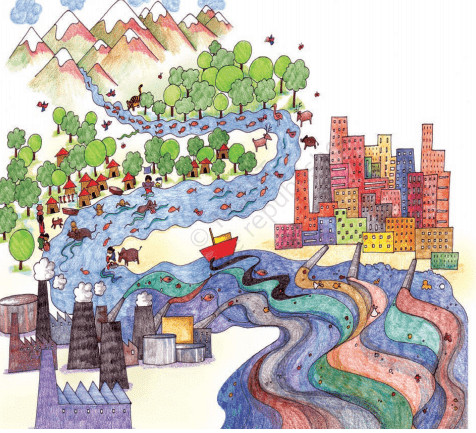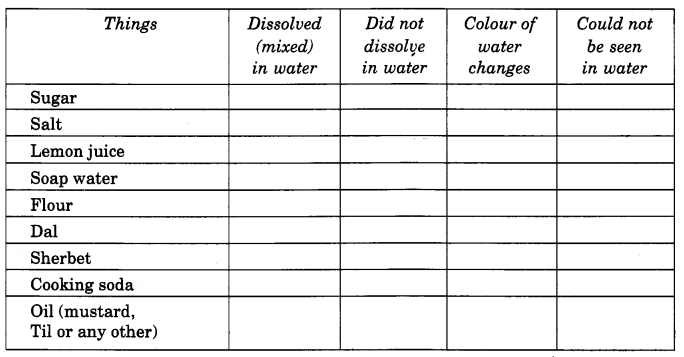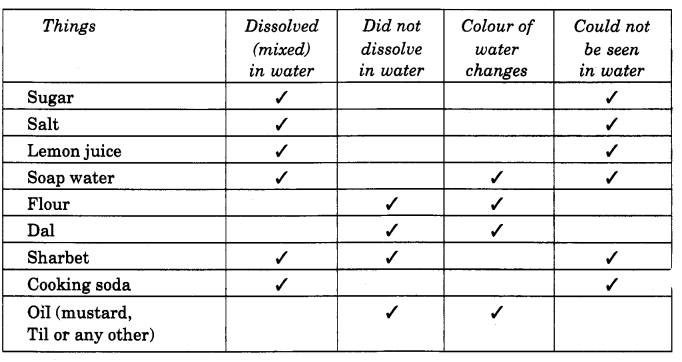NCERT Solutions for Class 4 EVS Chapter 13 - A River’s Tale
Page No 107

Ques 1: What is the colour of the river where it begins?
Ans: The river is blue at the place where it begins.
Ques 2: At some places, there are many fish in the river, at others there are only a few and at some places there are dead fish. What could be the reason for this? Discuss.
Ans: It can be seen that at the beginning of the river, its water is clean. But, as it reaches the village, people start polluting it by throwing garbage into it and bathing their animals in it. As the river reaches the city, the poisonous wastes of industries and the sewage are thrown into it. All these things make the water unfit for the fish and as a result, so many of them die.
Ques 3: What can be seen in the river before it reaches the village?
Ans: Before the river reaches the village, its water is clean and fresh. There are many fish in it and many other animals and birds come to it.
Ques 4: At which places did the colour of the water in the river change? Why did this happen? Discuss.
Ans: The colour of the water in the river changes when it reaches the city. This is because the industrial waste, the sewage and the garbage from the city are thrown into it, thereby polluting it.
Ques 5: Which of the places shown in the picture would you like to live in? Why?
Ans: I would like to live where the river started as the water there is clean and fresh there. Also, the environment there is very clean due to the presence of many trees.
Ques 6: Would you like to change any of the things that you see in the picture? Why and how?
Ans: In the picture, I would like to bring the following changes: In the villages, people should not bathe animals in the river water. In the cities, the sewage and the industrial waste should not be thrown directly into the river. The industrial waste should first be treated to remove the harmful chemicals from it. The treatment of the sewage should also be done before releasing the waste water into the river. All these will make the river water free from harmful chemicals and the lives of the animals living in the water will not be disturbed.
Page No 108
Ques 1: If you wanted to drink some water, from which part of the river would you like to drink? Why?
Ans: I would like to drink water from the beginning part of the river before it reaches the village. This is because the water of the river at this place is pure, clean and safe for drinking. As the river reaches the village, the water starts getting polluted and as it reaches the cities, its water becomes poisonous due to the dumping of industrial wastes in it.
Ques 2: In the last part of the picture the river flows into the sea. Have you ever seen the sea? Where? In a movie, or somewhere else? Ans:
Ans:
Disclaimer: The answer may vary according to the students’ observations and experiences. It is highly recommended that the students prepare the answer on their own.
Ques 3: Have you ever been near a river or sea? When?
Ans: There is a river in my city and I often cross the river. I have been near a sea during my trip to Mumbai.
Disclaimer: The answer may vary according to the students’ observations and experiences. It is highly recommended that the students prepare the answer on their own.
Ques 4: Show with your hands, how the waves in the sea move.
Ans: The waves moves up and down in the sea.
Disclaimer: The purpose of this section is to enhance the students’ creativity and imagination. It is highly recommended that the students perform this activity.
Ques 5: Is the water from the sea drinkable? Why?
Ans: The water from the sea is not drinkable because it is very salty, which is not good for health.
Ques 6: Do you think that there would be changes taking place in a river, pond or stream at different times of the year? What kind of changes would these be? Discuss.
Ans: In the summer season, the water level of the water bodies, such as river, pond or stream, decreases due to the evaporation of water. In the rainy season, the water level of the water bodies rises. The water of the ponds freezes in the winter in places where the climatic conditions are very cold.
Page No 109
Ques 1: Will there be the same amount of water in the ponds or rivers during the rainy season and in summer?
Ans: The amount of water in water bodies such as river and ponds is not the same during the rainy season and the summer season. In summers, due to hot climate, the water gets evaporated easily, whereas in the rainy season, the amount of the water increases due to rain.
Ques 2: Is there a pond, river or lake near your town or city ?
Find out–
(i) Are there any changes in the water during summers, the rainy season and in winters?
(ii) What are the different kinds of fish found there?
(iii) What kind of trees and plants grow around it?
(iv) What are the kinds of birds that come there?
(v) Have you ever seen or read about floods? Where?
(vi) What happens when there is a flood?
(vii) Have you seen dirty water in a river or pond?
(viii) How would you know if the water is dirty? If the water looks clean, can you be sure that it is alright to drink that water? Discuss.
Ans:
(i) Yes, in summer water level decreases. In rainy season water is at its maximum level. In winters it is at the middle level.
(ii) There are several kinds of fish found there. A few of them are Rohu, Katla, etc. They are of various sizes.
(iii) Mainly grasses grow around it.
(iv) Eagle, crow, swan, etc. come there.
(v) Yes. I saw flood, in Bihar.
(vi) Houses, roads, railway tracks are inundated when there is a flood.
(vii) Yes, I have seen dirty water in a river and in some ponds also.
(viii) The dirty water looks muddy and gives bad smell.
(ix) If the water looks clean, it may not be safe to drink that. A clean looking water may contain germs.
Disclaimer: The purpose of this section is to encourage the students to observe their surroundings. The answer may vary according to the students’ observations and experiences. It is highly recommended that the students prepare the answer on their own.
Page No 110
Ques 1: From where do you get your drinking water? A/ river or a lake?
Ans: We get drinking water from a river.
Ques 2: Do you think that like the river in the picture your river or lake can also be affected?
Ans: Yes, river that is near my town is also affected by pollution.
Page No 111
Ques 1: Put / mark in the right places.
Ans.
Now on the basis of your observations tell
Ques 2: Do all things dissolve in water?
Ans: No, not all things dissolve in water.
Ques 3: Does the colour of the water always change?
Ans: No, colour of water may not always change.
Ques 4: Did oil dissolve in water? How can you say whether it has dissolved or not?
Ans: No, oil did not dissolve in water. The things which do not dissolve in water either settle down or come up. For example, oirfloats on water.
Ques 5: Colour of the water may not change even after some things are dissolved in it. Would you say that these are absent in water?
Ans. If a thing is dissolved in water then it is present in water.
Ques 6: Imagine how it would be if things like sugar, salt, lemon juice, sherbet, etc., could not dissolve in water!
Ans: If things like sugar, salt, lemon juice, sherbet, etc. could not dissolve in water, we would not be able to cook food or have been things like tea, coffee, cold drinks, etc.
Ques 7: Imagine how it would be if things like stones, chalk, plastic and garbage would dissolve in water!
Ans: If things like stones, chalk, plastic and garbage would dissolve in water, then these things would make water dirty and, rather the world came to an end.
Page No 112
Ques 1: How is drinking water cleaned in your house?
Ans: By boiling, adding alum, etc.
Disclaimer: The purpose of this section is to encourage the students to observe their surroundings and be interactive. The answer may vary according to the students’ observations and experiences. It is highly recommended that the students prepare the answer on their own. The answer provided is just for reference.
Ques 2: Find out the many different ways of cleaning water at home.
Ans: Different ways of cleaning water at home are as follows:
1. Boiling of water: This method kills the harmful germs present in the water. 2. Chemical treatment: Various chemicals such as chlorine can be added to the water depending on the type of impurity present in it.
3. Filtration: Impurities and germs present in the water can be filtered out by using water purifiers. There are several other ways of purifying water.
Ques 3: Draw pictures showing any two ways of cleaning the water.
Ans: There can be several other ways of cleaning water.
There can be several other ways of cleaning water.
|
52 videos|352 docs|54 tests
|
FAQs on NCERT Solutions for Class 4 EVS Chapter 13 - A River’s Tale
| 1. What is the significance of rivers in our ecosystem? |  |
| 2. How do rivers get polluted? |  |
| 3. What are the different stages in a river's life cycle? |  |
| 4. How do rivers contribute to the economy? |  |
| 5. How can we conserve and protect rivers? |  |
















